How to Win With Marketing Competitive Analysis Across Search’Social
How exactly to Win With Marketing Competitive Analysis Across Search & Social
Your organization is shaped, partly, by the competitive landscape where it operates.
Here’s a great way to consider it: Your business is really a band, as well as your competitive landscape is its historical context. Joy Division-one of the very most celebrated post-punk bands ahead from the UK-was shaped, partly, by trailblazers just like the Stooges. In turn, once you listen to the first work of The Cure, Joy Division’s influence is clear.

A straightforward snapshot of a hypothetical competitive landscape.
If you wish to understand a legendary musical act, you must have a long, hard go through the other artists around them. And when you intend to understand your business-your strengths, your weaknesses, your opportunities for differentiation and growth-you need to absorb your competitors. Failure to activate in what’s referred to as competitive analysis may bring about poor decision-making, missed opportunities for revenue, and reduced market share.
That is an introductory guide to conducting competitive analysis across search and social. Once we’ve defined competitive analysis, we’ll discuss the fundamentals of evaluating your competition through the lenses of PPC, SEO, and social media.
Exactly what is a marketing competitive analysis?
A marketing competitive analysis may be the ongoing procedure for scrutinizing your competitors with regards to your personal business. It’s the act of examining each company in your market and determining the method that you stack up with regards to product, marketing, sales, copy, and much more.
The target is to draw conclusions that simplify the decision-making process. If your analysis of Competitor A leads one to the conclusion that you’ve got a clear advantage in organic search, you might decide – for the moment – to spotlight creating improvements to your paid media strategy. Had you not taken enough time to draw this conclusion, you might have invested limited marketing resources in suboptimal fashion.
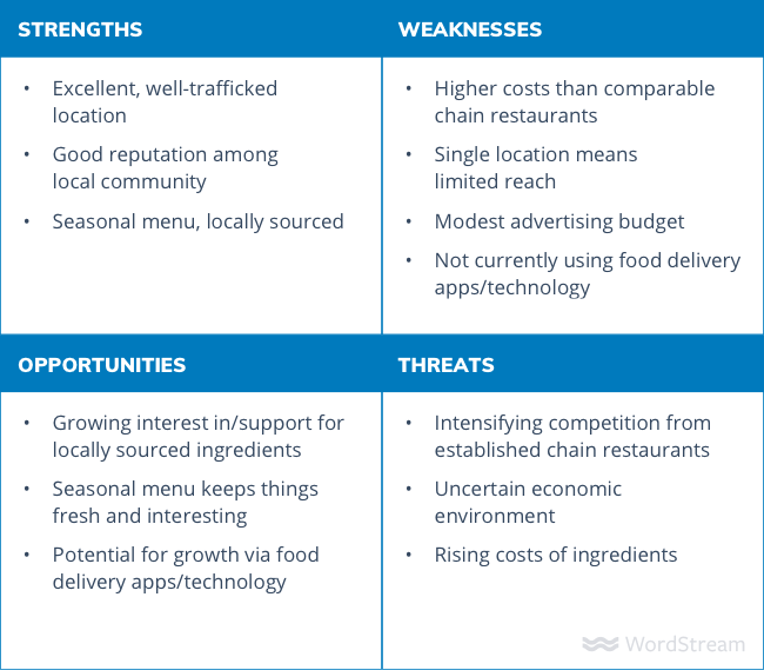
The SWOT format is one method to organize insights gleaned from the competitive analysis.
Competitive analysis can (and really should) be employed to every element of your business, but also for now, we’re likely to focus exclusively on digital marketing. Hopefully, if you’re in a position to take the ideas shared below and formalize them with processes and templates, people from other parts of one’s organization could have a head start.
Marketing competitive analysis: search engine marketing techniques
PPC and SEO each have their very own benefits and drawbacks; in most cases, it behooves one to strike a balance between your two. Plus, I’m ready to bet that each of one’s competitors is, somewhat, investing in one of these brilliant channels-if not both.
Competitive analysis for PPC
Our PPC competitive analysis includes three key focus areas: keywords, positioning, and will be offering.
Keywords
Your closest competitor can be your closest competitor since they sell something or service that’s much like yours. It follows, then, that they’re probably bidding on lots of the same keywords that you’re bidding on. (And when you’re in an especially competitive market, they could even be bidding on your own brand.)
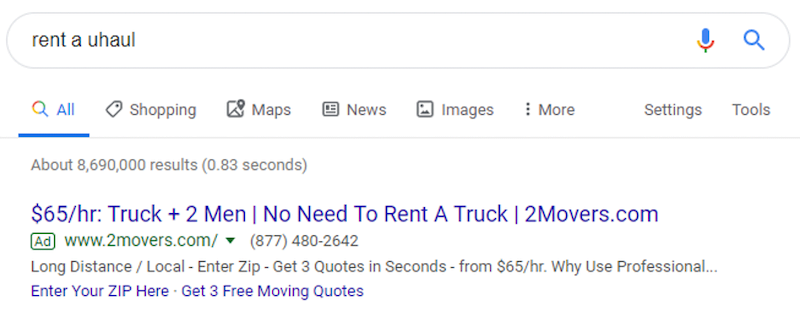
Always good to look for things like this.
To really get your competitive analysis started, there are many questions to take into account:
- Which keywords are you currently winning? As you review the keywords you have as a common factor with your competitor, observe your strongest performers. Which metric(s) you utilize to recognize your strongest performers is entirely your decision. By no means in the event you get complacent about these keywords – on any given day, your competitor may be brainstorming other ways to overtake you on the SERP – nonetheless it doesn’t make much sense to invest your time attempting to fix a thing that isn’t broken.
- Which keywords are you currently losing? Utilizing the same metric(s) you used to recognize your strongest performers, observe your not-so-strong performers. Take into account that your top keywords are proof your capability to beat your competitor in the paid serp’s. So, what’s going wrong here? Whether you will need to shrink your ad groups or refresh your squeeze page copy, be sure to identify a minumum of one concrete way to have more value out of the under-performing keywords.
- Which keywords are shared? Because your prospects are typing never-before-seen queries in to the Google search bar each day, you should continually be searching for new keywords that neither you nor your competitor are benefiting from. Picture yourself claiming the very best spot for a keyword that’s not yet even on your own competitor’s radar. What’s much better than that?
Positioning
Beating your closest competitor in the paid serp’s for all your best keywords is pointless if you’re struggling to position your service or product effectively. Plus, if your lackluster messaging results in poor click-through rates, it won’t be a long time before your top impression share begins to decline.

Top impression share = Top impressions / Opportunities for top level impressions
Below are a few questions to consider through the positioning part of your competitive analysis:
- What does your competitor have a tendency to emphasize within their ad copy? Whether their messaging will concentrate on features or outcomes, focusing on how they position themselves lets you differentiate your service or product. If, for instance, your competitor emphasizes the comprehensiveness of these solution, you may consider emphasizing the intuitiveness of one’s solution. What’s important is that you’re using competitive analysis to make sure your messaging isn’t run-of-the-mill.
- Has your competitor’s emphasis recently changed? Here’s where in fact the ongoing section of competitive analysis really is necessary. Staying together with your competitor’s positioning in the paid serp’s enables you to detect any changes they make-changes that could indicate a fresh direction and/or revenue stream. As a few of you might know from experience, getting blind-sided may be the last thing anybody wants.
- Where are your competitor’s gaps? As you obtain better and better with competitive analysis, you might begin to notice gaps in your competitor’s positioning – specific pain points or outcomes or features they fail to address making use of their PPC ad copy. Have a look at the search queries which are triggering both your ads as well as your competitor’s ads. Are your prospects looking for something that’s nowhere found in your competitor’s ad copy? A thing that you can talk with and use to operate a vehicle traffic?
Offers
Positioning, though important, isn’t the only real factor your prospects consider when evaluating the paid serp’s. If you wish to turn those impressions into clicks-and direct clicks from your competitor-you have to create valuable and differentiated offers.
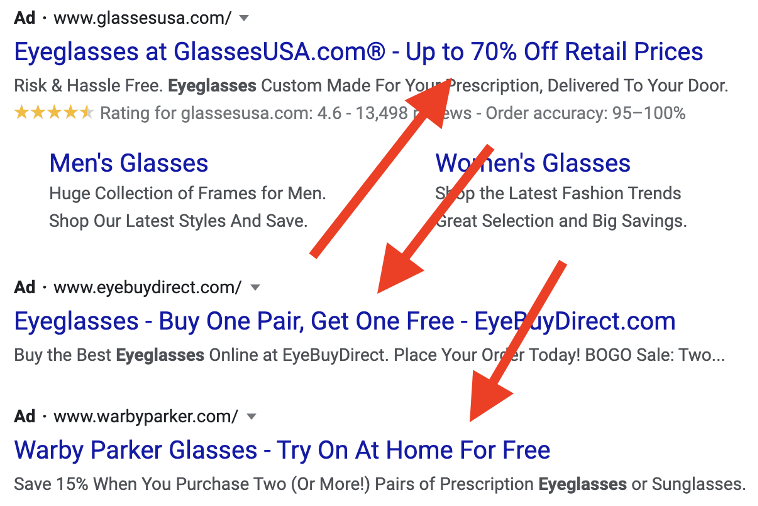
Think about the following:
- That provides do you as well as your competitor have as a common factor? Two businesses bidding on a single keywords as you another will probably depend on similar offers: free shipping (ecommerce websites), free trials (D2C brands), demos (B2B companies), etc. Because certain forms of offers work well for several forms of businesses, it’s inevitable that you’ll involve some amount of overlap. Making note which offers both you as well as your competitor are using lets you test out your PPC ads. And when you’re wondering why by that …
- Can you see opportunities to test out your ad copy? Today’s PPC ads would look pretty foreign to a person who hasn’t used the web since 2012. Headlines are longer, descriptions are richer, and extensions tend to be more diverse. As search ads expand, marketers have significantly more and more opportunities to use new placements of these offers-and, along the way, differentiate themselves from their competitors. If your competitor is continually placing their offers by the end of their headlines, do something differently! Not all experiments will undoubtedly be successful, but failing woefully to stand out is really a much worse fate.
- Are your competitor’s offers aligned with keyword intent? The potency of an offer is set, partly, by how well (or poorly) it aligns with the intent of the chance. If you’re marketing auto insurance, it doesn’t make much sense to provide a free of charge quote to someone searching “so how exactly does auto insurance work.” Observe any instances where your competitor’s offer has gone out of sync with keyword intent – they are opportunities to place appropriate, differentiated offers front-and-center in your PPC ads.
Marketing competitive analysis for SEO
Our SEO competitive analysis also includes three key focus areas: keywords, backlinks, and SERP features.
Keywords
Although, mechanically speaking, PPC and SEO will vary, keywords essentially play exactly the same role across both of these disciplines: we target them hoping of driving traffic to your sites.
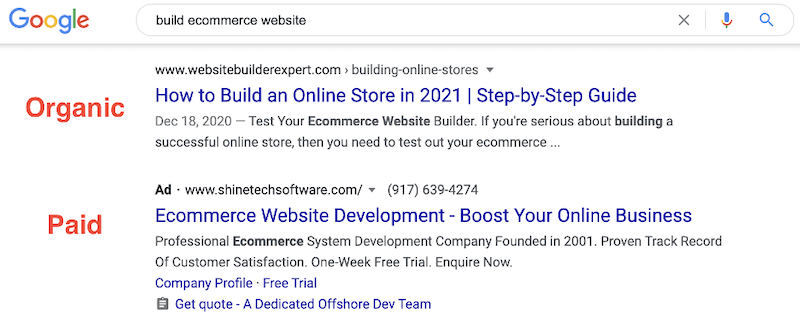
Therefore, our three basic questions so you can get your competitive wheels spinning will be the same:
- Which keywords are you currently winning? With regards to metrics, this question is more straightforward than its PPC equivalent: That (non-branded) keywords are you currently outranking your competitor? Again, the goal of identifying these keywords isn’t to justify complacency, but instead to simplify the duty of setting priorities. You almost certainly don’t have time and energy to optimize your site content for each keyword.
- Which keywords are you currently losing? Unless you’re HubSpot or Wikipedia, you’re probably getting outranked by your competitor for several high-value keywords. Again, you’ve proven you could win the SERPs in your niche. So, have a look at the under-performing content and produce some ways to enhance your rankings: write additional copy, compress images to boost page speed, increase keyword density, etc.
- Which keywords are shared? Same story here: Each day brings new, unique search queries that nobody has ever searched before. It’s insufficient to merely play catch-up on the keywords you’re already losing; you’ve surely got to stick to top of emerging keywords that neither you nor your competitor are targeting. SEO software pays to towards this end, but don’t just forget about Google Search Console. In the event that you dive in to the queries which are driving traffic to your website, you’ll probably find valuable keywords that you’ve yet to directly target with a focused little bit of content.
Backlinks
There’s more to SEO than keyword targeting. If you wish to function as leader in your market in the organic serp’s, you will need a strong profile of links pointing to your internet site from high-quality sources (i.e., trusted websites in related or adjacent markets).
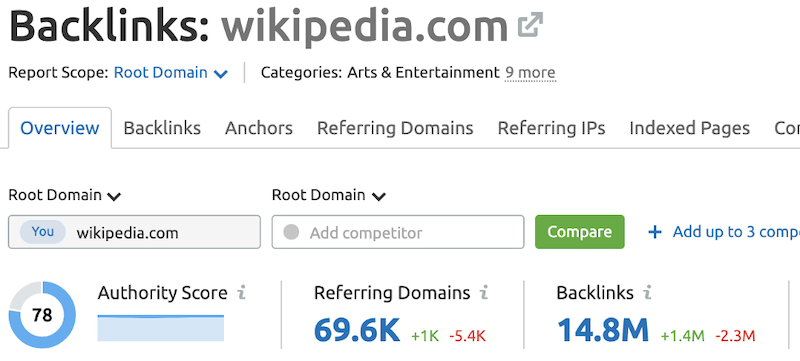
A synopsis of Wikipedia’s backlink profile, in accordance with SEMrush.
That’s why backlinks will be the second focus area inside our SEO competitive analysis. Remember that you’ll require a third-party SEO tool to answer the next questions, consider:
- So how exactly does your level of backlinks equate to that of one’s competitor? Though quality trumps quantity when we’re discussing backlinks, it’s worthwhile to accomplish an instant volume comparison between you as well as your competitor. Why? Say, for instance, that your competitor will outrank you for high-value keywords, nevertheless, you find that you’ve accumulated nearly doubly many backlinks because they have. That is useful information, as it might indicate that, normally, your competitor attracts higher-quality links than you do.
- Who links to your competitor, and just why? No matter any differences in volume, you have to know, in an easy sense, which domains connect to your competitor-as well as why those domains connect to your competitor. Instantly, it should be simple enough to determine why a particular domain has chosen to provide your competitor a backlink. If it’s a publisher that covers stories and topics linked to your market, they’ve probably deemed your competitor to be always a worthwhile resource for his or her readers. If it’s an odd-looking domain which has nothing whatsoever regarding your market, it’s probably a useless, spammy link that’s unworthy of your energy.
- Is it possible to identify any untapped opportunities? Commensurate with an emerging theme of the blog post, you need to continue to keep your eyes peeled for untapped opportunities-i.e., worthwhile domains that connect to neither you nor your competitor. Say you sell homemade coffee mugs during your ecommerce site and you also stumbled upon a popular publisher having an article titled “The 24 Best Coffee Mugs WE ARE ABLE TO Find on the net.” If neither you nor your competitor is mentioned in this article, that could be a good possibility to contact the publisher and have if they’d consider reviewing your mugs.
SERP features
As satisfying since it would be to outrank your competitor on high-value keywords, winning special features on the SERP-most notably the featured snippet, among others-is another solution to gain a competitive advantage in your market (and an extremely prevalent one, I would add).
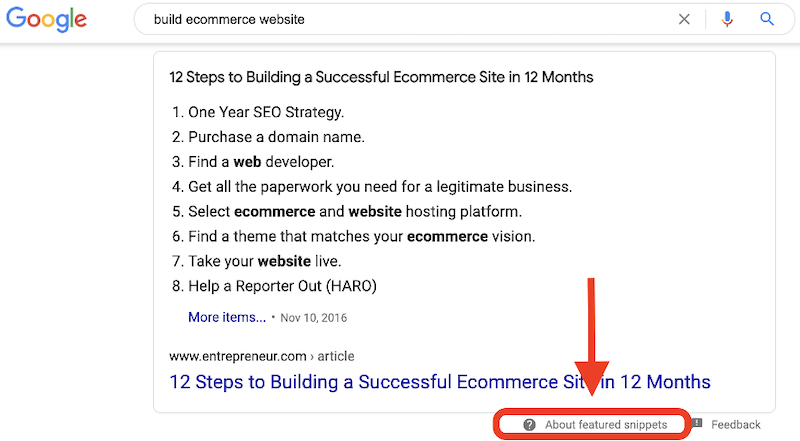
To summary the SEO portion of our competitive analysis, think about the following:
- Do you have a SERP feature for just about any keywords? Whether it’s a featured snippet, a remedy to a related question, or perhaps a YouTube video that surfaces in the serp’s, you might own a SERP feature for a high-value keyword without even realizing it. If that’s the case, it’s worth making the effort to formulate an informed guess as to the reasons you possess that feature – in order to make an effort to replicate whatever it really is you did correctly!
- Does your competitor own a SERP feature for just about any keywords? Another good usage of your time is locating the keywords that your competitor owns a SERP feature. Say there’s an especially valuable keyword that both you as well as your competitor are targeting and they’re the people who own the featured snippet. Ugh. But, wait one minute – and a featured snippet, the SERP for that keyword also contains YouTube videos, and neither you nor your competitor has generated a targeted video. If YouTube is section of your content online marketing strategy, perhaps it ought to be a priority to create that video ASAP.
- Is it possible to edit your articles to win any untapped opportunities for SERP features? Finally, do some digging and see if you can find any keywords that (1) both you as well as your competitor are targeting and (2) usually do not trigger certain SERP features you’ve deemed desirable and/or attainable. Is it possible to restructure a bit of content to create it an improved candidate for a featured snippet? Is it possible to update a bit of quite happy with ancillary keywords to produce a run for the related questions feature? Is it possible to rename among your YouTube videos to provide it a better potential for surfacing on the SERP for a particular keyword? Compete and strategic together with your optimizations!
Marketing competitive analysis: social media marketing
Congratulations! Because of the energy of competitive analysis, you’re now better positioned to go head-to-head together with your rival in the search results-both paid and organic.
Search engine marketing techniques is powerful since it allows you to provide worth to your leads when they’re online with intent (whether it’s educational intent, industrial intent, or something among). But, think about those occasions when your prospects are employing the internet without the sort of intent?

Facebook & Twitter are being among the most trafficked sites in america, per Ahrefs.
That’s where social media comes into have fun with. The value of social media is a subject worth its blog post-perhaps its blog-but for the present time we’ll concentrate on one central problem:
As you have limited time and energy to improve your social media strategy, you must understand what your competitor will be and isn’t doing – along with what these insights expose in terms of possibilities for differentiation and development.
Your help to conducting a simple social media competitive evaluation is damaged, unsurprisingly, into three key concentrate locations: channels, paid content material, and organic content material.
Channels
Through the entire PPC and SEO parts of our competitive evaluation guide, it was secure to assume we had been discussing Google and Bing; almost all search on the internet activity is, in the end, handled by both of these businesses.
Social media is really a different tale. Yes, Instagram’s parent firm Facebook is really a tech huge on par with famous brands Search engines and Microsoft (which owns Bing). Nevertheless, the number of social media marketing channels open to digital marketing experts is much larger than the selection of (worthwhile) search motors available to digital entrepreneurs.
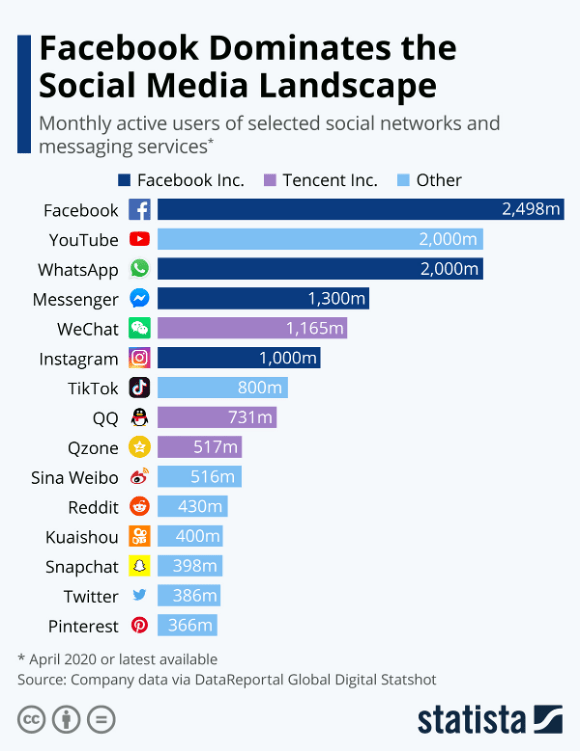
So, even though you’re a B2B marketer who cannot care much less about Snapchat or TikTok, let’s begin our aggressive analysis with several considerations related to stations:
- Where are you currently and your competitor energetic? Certainly, the solution to this question will probably depend, in large component, on the type of business you’re advertising. Whereas someone advertising a D2C brand name may focus mainly on Instagram and TikTok, a marketing expert at a B2B consulting corporation may care solely about LinkedIn and Twitter. Regardless of what, it’s useful first of your evaluation to obtain a general sense which channel(s) you as well as your competitor took most seriously until this aspect. If you’re both publishing incredible articles on LinkedIn, but neither of you does anything fascinating on Twitter, consider ways to start providing more worth to your supporters on the latter system.
- Which channel promises the best opportunity for development? If you’re in times where both you as well as your competitor are usually crushing it using one channel and approaching short on another, after that this is a straightforward question to reply: the latter channel is probable the one that claims the greatest chance of growth. But items are seldom so dark and white-and if you’re in a competing niche, you’re likely up against individuals who know very well what they’re doing. Therefore, to dig a little deeper, consider: Recently, over the stations where you’re energetic, which includes been delivering the very best results, and which includes been probably the most stagnant? Perhaps you have noticed a steady upsurge in Instagram video sights as your Facebook engagement provides leveled off? Whatever it really is, trust your information and your gut to inform you which channel to prioritize.
- Any kind of emerging channels you ought to be using? Though this final issue isn’t of equal significance to every internet marketer, the explosive development of TikTok in the ultimate moments of the 2010s illustrates precisely how rapidly a fresh social media marketing channel can increase to prominence (as well as dominance). Given your specialized niche and the amount of competition you’re against, your competitive achievement in the coming yrs may depend, partly, on your capability to establish a existence on the emerging channel that’s generating buzz. If you shouldn’t throw cash at something purely because it’s shiny and brand-new, you know what they state about earlier adopters.
Paid content material
There’s several way to get worth out of a social media marketing channel-quite several, actually. But, in probably the most general feeling, online marketers have two (non-mutually special) options: paid content material and organic content material.

Paid articles on LinkedIn.
Concerning the former, listed below are three queries to think about:
- How come your competitor running societal advertisements? Without espionage (that is in no way justifiable), you can’t solution this query definitively-and that’s fine. Absorb the types of advertisements they’re working, the tone of these duplicate, the CTAs they’re making use of, and so on. Predicated on these observations, can you say they’re concentrated mainly on brand awareness? To generate leads? In-store conversions? The solution will likely change over time-maybe seasonally, depending on what sort of marketplace you’re in-and that’s the wonder of regularly conducting aggressive analysis. Picking right up on these adjustments and trends offers you an incredible amount of insight into your competitor’s strategy.
- So how exactly does your competitor place themselves within their social advertisements? Recall the positioning portion of our PPC competing analysis. In your copywriting process, take time to know how your competitor will be positioning themselves within their social advertisements. What pain factors do they have a tendency to address? What functions or outcomes perform they have a tendency to emphasize? Any kind of gaps within their messaging that you could complete? Because paid lookup and paid interpersonal are so basically different, the duplicate your competitor writes for Google may be worlds in addition to the duplicate they write for Facebook. And remember: the objective of this exercise isn’t to imitate, but instead to make sure that your duplicate isn’t stale.
- What types of offers can be your competitor producing to potential customers? Whenever we discussed gives during our PPC aggressive analysis, our concentrate was on complementing keyword intent. Keyword intent, needless to say, doesn’t actually exist on social. Therefore, once you analyze the presents your competitor is producing with their social prospects, make use of that intel to create an educated guess in regards to what forms of prospects they’re seeking. Can be your competitor in the lawful services market utilizing their social ads to provide an ungated educational movie? They’re probably targeting cool viewers with the intent of spreading recognition. Can be your competitor in the hospitality marketplace utilizing their social ads to provide discounted rates? They’re possibly targeting warm viewers with the intent of generating conversions.
Organic content material
As effectual as social ads could be, you’re carrying out yourself a disservice if you’re overlooking organic content material entirely. It is possible to only throw around some money monthly, and non-paid content generally gives businesses greater versatility to activate their audiences in special and creative methods.

Organic content material on Twitter.
Knowing that, let’s summary our competing analysis with three last questions to take into account:
- What’s your competitor doing making use of their organic content material? Organic sociable content will come in many sizes and shapes. Some marketers utilize it to begin conversations making use of their customers and leads. Others use it to create original articles that can’t be discovered anywhere else-almost such as a second blog page or YouTube channel. Online marketers who are especially crunched for time make use of organic social mainly to post links. As soon as you’ve identified what your competitor does with their organic content material, you’ll possess the intel you must do something much better. Are they mainly posting links? Great-begin publishing thought-provoking articles. Are usually they neglecting to connect to users? Awesome-go fill up that gap when you still have the opportunity.
- Just how much engagement will your competitor obtain from customers? As you’re analyzing your competitor’s organic cultural feeds to find out what kind of content material they’re publishing, it’s also advisable to observe the engagement they’re obtaining. If it appears that they’re making a genuine effort to talk about original, valuable articles, but their engagement amounts are unimpressive, that could indicate something substantial about your shared market. Is your competitor talking with a pain stage that users don’t in fact value? Are they product packaging their content material in a structure that customers find unappealing? It is possible to learn a whole lot from the efficiency of one’s competitor’s organic articles.
- Where are usually your competitor’s content material gaps? That is essentially the same issue we asked by the end of the positioning portion of our PPC aggressive analysis. Predicated on what you find out about your audience-pain factors that maintain them up during the night, features they need, outcomes they’re functioning towards-can you identify whatever your competitor will be failing to address making use of their organic social articles? To place it in more common terms, how will you use your natural content to supply value that your target audience isn’t obtaining from your own competitor?
Ensure it is a habit to carry out your marketing competitive evaluation!
At the chance of beating a lifeless equine, I’ll say it once more: Competitive evaluation, whether you’re centered on PPC, SEO, social media, or some mixture thereof, can be an ongoing procedure. Can one-off insights occasionally be helpful? Needless to say. But when you ensure it is a habit to frequently conduct competitive analysis as time passes, you begin to detect patterns, developments, strategic shifts-the forms of insights that may truly make a direct effect.